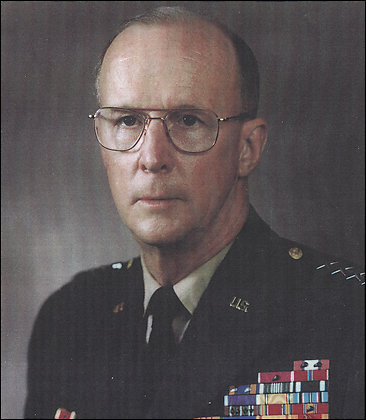Walter Kerwin, Army General Instrumental in Ending Draft
By Matt Schudel
Courtesy of the Washington Post
Sunday, July 20, 2008
Walter T. Kerwin Jr., 91, a retired four-star General who was the Army’s second-highest-ranking officer in the mid-1970s and an architect of the all-volunteer Army, died July 11, 2008, of respiratory failure at the Washington House nursing facility in Alexandria, Virginia. He was an Alexandria resident.
In the early 1970s, during the Vietnam War, the military draft was deeply unpopular and desertions were common. In 1971, the Army’s desertion rate of 62.6 per 1,000 troops nearly equaled the Army’s all-time high of 63 per 1,000 in 1944. Social problems, including drug abuse and racial strife, were evident throughout the military.
As the Army’s Deputy Chief of Staff for Personnel, General Kerwin helped create a policy that scrapped the draft and led to the launch of an all-volunteer Army in 1973.
“We think that the programs we have initiated, and our coming out of Vietnam, should enable us to turn the corner and bring this level of indiscipline down,” General Kerwin said during a congressional hearing.
The voluntary enlistment program has been in place for 35 years and is credited with the development of a more effective and professional fighting force.
In 1974, General Kerwin was named Vice Chief of Staff, the Army’s No. 2 official. (His superiors were General Frederick C. Weyand and, later, General Bernard W. Rogers.) During his four years as Vice Chief, General Kerwin sought to raise salaries, educational standards and morale. He also promoted the “total Army” concept, which put the National Guard and Army Reserve onto more equal footing with the Army.
General Kerwin was born June 14, 1917, in West Chester, Pennsylvania, and was a 1939 graduate of the U.S. Military Academy at West Point, New York. As an artillery officer during World War II, he helped coordinate a massed artillery barrage that helped Allied forces make a successful beach landing at Anzio during the Italian campaign of 1944.
He also fought in North Africa and Sicily before being wounded in December 1944 in France. After the war, he held positions in intelligence and taught artillery methods to the Turkish army before being assigned to the Los Alamos National Laboratory in New Mexico in 1953. He helped coordinate the transportation of nuclear weapons for testing in Southwestern deserts and in the Pacific.
After attending specialized Army training schools, General Kerwin was sent to Germany in 1961 to command an artillery division as a newly promoted Brigadier General. He moved on to Allied military headquarters in Paris in 1963 as the officer responsible for nuclear targeting in Europe.
General Kerwin served in Vietnam from 1967 to 1969 and took on his role as Deputy Personnel Chief at the Pentagon in 1970. He retired in 1978. His decorations included the Defense Distinguished Service Medal, three awards of the Army’s Distinguished Service Medal, two awards of the Legion of Merit, the Bronze Star and Purple Heart.
In retirement, General Kerwin was a consultant to the Martin Marietta and Lockheed Martin corporations and was a senior evaluator of emergency mobilization plans for the Joint Chiefs of Staff. He also represented the Defense Department in negotiations with foreign-owned defense contractors.
Soon after his retirement, he became chairman of the Army and Air Force Mutual Aid Association, which provides insurance to military families. He greatly increased the association’s membership and financial assets and was chairman emeritus until his death.
He served on a scientific advisory group evaluating the effects of nuclear warfare and was a member of the boards of the National Defense University, Army Emergency Relief Association and Army Historical Foundation. He was also a director of General Employment Enterprises Inc., an executive placement firm.
The nonprofit Association of the U.S. Army named an annual award in General Kerwin’s honor to recognize the military readiness of outstanding National Guard and Army Reserve units across the country.
In 1993, the D.C. chapter of the West Point Society gave General Kerwin the Castle Memorial Award as a distinguished graduate of the U.S. Military Academy.
His first wife, Barbara Kerwin, died in 1980.
Survivors include his wife of 23 years, Marion McCutcheon Kerwin of Alexandria; two children from his first marriage, retired Army Lieutenant Colonel Bruce R. Kerwin of Spokane, Washington, and Ann Walker Kerwin of Alexandria; two stepchildren, Marion Donovan of Goose Rocks Beach, Maine, and Keith B. McCutcheon of Wilmington, Delaware; three granddaughters; and five great-grandchildren.
WALTER T. KERWIN, JR. “Dutch” General, United States Army (Retired) On July 11, 2008 of Alexandria, Virginia.
He was the Former Vice Chief of Staff, U.S. Army. Beloved husband of Marion T. Kerwin; loving father of Bruce R. Kerwin and Ann Walker Kerwin; step-father of Marion Donovan and Keith B. McCutcheon, Jr. He was a caring grandfather and great-grandfather. He was preceded in death by his first wife, Barbara in 1980.
Funeral services will be held on Tuesday, August 5, 2008 10 a.m. in the Memorial Chapel on the grounds of Fort Myer. Interment to follow at Arlington National Cemetery with full military honors.
In lieu of flowers, contributions may be made to the National Museum of the U.S. Army Memorial Fund, 2425 Wilson Blvd., Suite 520, Arlington, Virginia 22201 or the Army Emergency Relief, Attn: Donations, 200 Stovall St., Room 5913, Alexandria, Virginia 22332.
Michael Robert Patterson was born in Arlington and is the son of a former officer of the US Army. So it was no wonder that sooner or later his interests drew him to American history and especially to American military history. Many of his articles can be found on renowned portals like the New York Times, Washingtonpost or Wikipedia.
Reviewed by: Michael Howard

